On most bus systems I’ve seen, information about the route is on a changeable sign, not painted or printed on the bus itself. Many bus operations have constrained facilities and need to be able to quickly deploy whatever bus is handy to meet a need, so bus operations folks resist marketing ideas that involve making the buses too specialized. The more different kinds of buses there are, the more likely it is that the one they have handy will not be the one they need.
But several British bus operators disagree. In both Birmingham and Cardiff, I noticed many buses decorated specifically for use on one route, or one closely related family of routes.
Here are some examples from Cardiff (Welsh on one side of the bus, English on the other):
Birmingham’s buses, by National Express, lack that list of destinations along the top but have other information, often with an emphasis on comfort.
While the Birmingham buses convey useful information, I really like the Cardiff design, especially the list of destinations along the top of the vehicle. For someone who knows the city, these give a quick and useful sense of what the bus does; for the visitor, they at least advertise destinations that might be of interest.
Many historic public transport vehicles used to be marked with a list of destinations painted on the vehicle. You can still see this on some San Francisco cable cars:
And of course, the same tool is used now and then for commercial services that only do one route. But I was struck in Birmingham and Cardiff by how widely these were deployed: Not on every route, but seemingly on the most frequent ones.
European cities are hard to navigate. A route can’t be named after a single main street that it uses, as is often possible in North America. Instead, every route’s identity can only be conveyed by a list of places. As I’ve explored various British cities where I didn’t know the network well, I found myself valuing this prominent information about each route. I also appreciated how these buses, especially the Cardiff ones, invite me to think about possible trips I could make in the future. They help me see my options.
The operational barriers to doing this are real. I have seen many North American operating bases that are far too constrained to enable buses to be dispatched this way, with a separate stack of buses reserved for each route. But it could be part of making buses more attractive to people, in cities where that’s an issue.
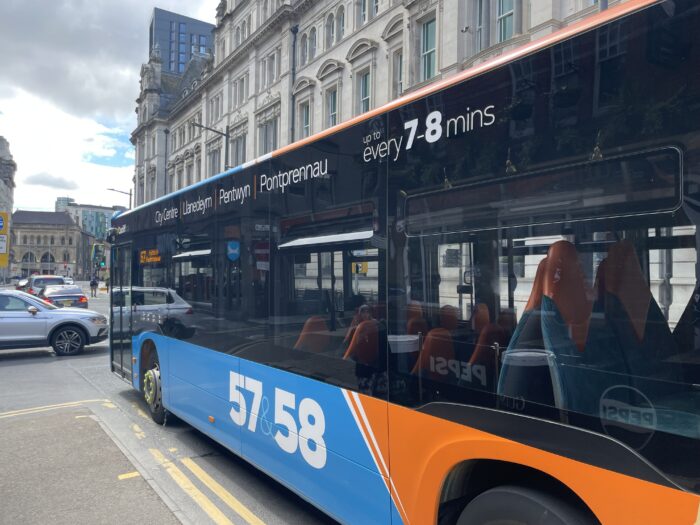
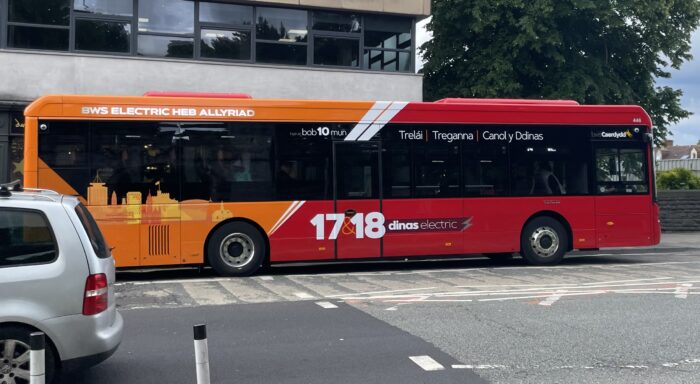
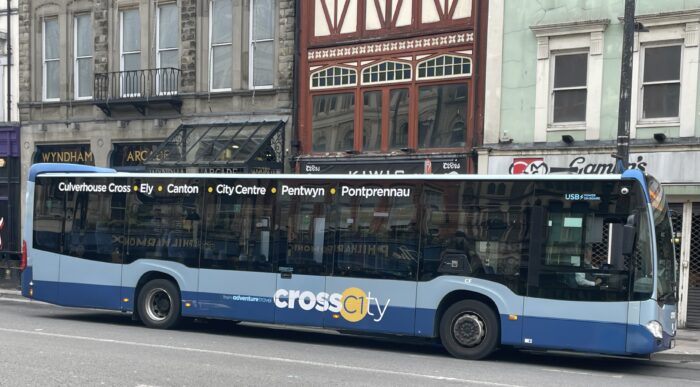
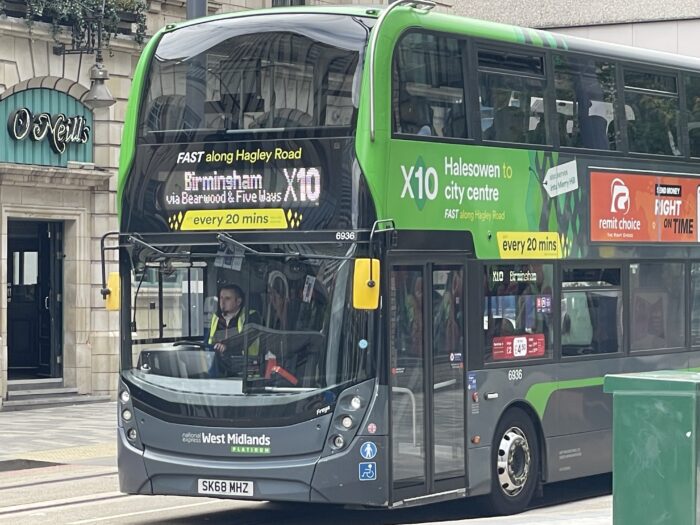

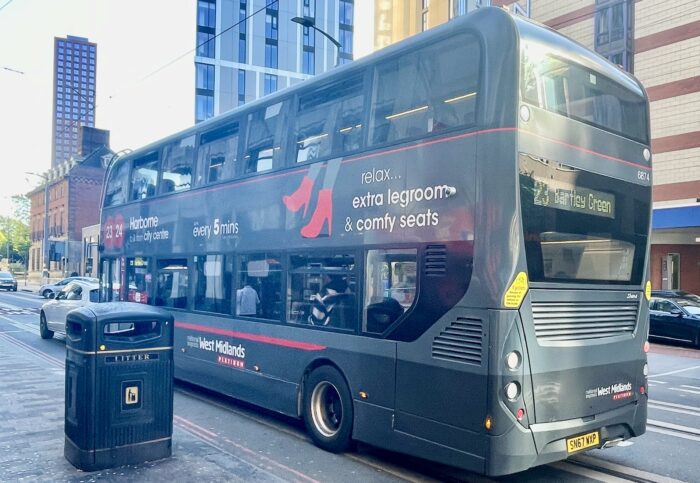

Painted route branding often leads to less efficient scheduling. Normally, the same vehicle is used for multiple routes during the same day. Since this is not possible with route branding, you often need more vehicles, and more drivers to be paid. It also makes it harder to create runs that complies with the work rules, this also increases the need for drivers and can also lead to runs that are less attractive to drivers.
Remember the real reason for why painted route branding is so common in the UK: deregulation. When multiple operators compete for the same passengers, marketing becomes very important. In London, where buses are not deregulated, all buses have the same livery, and the same in the re-regulated bus network in Manchester. If the rest of the UK also re-regulates the buses, painted route branding will most likely disappear.
I’m surprised! I would’ve thought most buses start at the depot, do however many runs up and down the same line, then back to the depot for driver change and cleaning.
I can see that this might be different with infrequent routes though.
There are usually requirements and restrictions like, the end of the line needs to have parking suitable for buses and a place where the driver can use the bathroom and take lunch, etc.
Particularly for routes that go to city center, it’s not often feasible to have a lot of buses park, and so the bus may be paired with a shorter route to get the driver to facilities.
Jonathan, most busses do start at a depot, do a certain number of runs, and then return. The issue is that most depots serve multiple lines and share a pool of busses for all of them. For instance, if you have ten routes that need 10 busses each, and can expect 2% of busses to be down for maintenance, then your depot needs 102 busses (100 busses in the road and 2 spares for maintenance). But if you brand busses by route, you need 110 busses (100 on the road and 10 spares – one for each route – of which 2 are in maintenance and the other 8 are just sitting around).
As others have noted you can get around this by having your maintenance spares unbranded to give flexibility.
In my experience, it’s more common than not that buses run different routes on the same block, although this varies greatly from place to place. For example, in Akron, many routes terminate at RKP Transit Center and changing route is the norm there. You can see it all in the pdf schedules: https://www.yourmetrobus.org/Data/Sites/2/pdf/schedules/spring2024/route25_spring2024.pdf
In London, Superloop buses are painted with route information.
Some colour-coding of major route “bundles” would be an alternative.
I’m thinking of a collection of routes that share a distinct artery for a portion of their journeys. It would help to pick out at a distance (or through rain) which buses to flag.
A case you may remember is in Sydney where many buses start in the CBD and travel down one street for the first 1-2 km, but then split off into 3-4 different directions for the next 2-5km and then branch again.
This reminds me of the old Tri-Met maps in Portland, where there were 6 or 7 sectors, with routes in each area drawn in a different color on the system map, with crosstown routes in black. Making the physical buses different colors too would have been fun and useful. Being from the Twin Cities, and having returned after bopping around the US and Canada in the 1990s and early 2000s, I always like the “purple rain”, LOL!
Or do both – coloured bundles AND major destinations. Well you can’t swap out buses if the colour is painted, would there be an option to get bands of LED lights? Turn red lights on for the red line, green on when running the green line, etc.
The old trolleys here in Halifax, Canada, had lights on the front. Different combos (and maybe colours) would should the route, in addition to signs (e.g. Beltline, Gottingen, etc.). Presumably the lights could be seen at a longer distance than the signs were legible. If they could do that in the 1920s, surely it’s doable today.
Paris use colour LED destination signs to give this differentiation.
As someone who is colorblind: please don’t. If you do be ready for an ADA lawsuit because your signs are not readable. I have been in the position of not knowing what bus was coming because I couldn’t read the sign. (fortunately I never had to use that route so it didn’t matter if it was east or west bound)
Colors are a poor option for lines anyway. Only tiny cities have so few routes that color is a reasonable differentiator anyway (is that the teal or the green line coming?). Color is useful for branding a service level in some cases, but you should have more routes that useful colors. In all cases color needs to go with something else (all express buses are red and route numbers are 4xx…)
Why assume a bus should not serve a route different from which painted on its body? It’s frequently observed in Hong Kong and no one complains on the confusion.
With the decreasing costs and weight of digital signs, couldn’t we find a middle ground — something like the Cardiff signs, but on digital screens running the length of the bus? Swap the bus to a new route, just flip the switch on a new sign. Almost every agency already does this on the front signs above the windshield.
I semi-routinely see more generically-branded buses on these routes as well, so I think it’s that 90% or even 100% of the buses needed for those routes have the livery, but the ‘spare’ or ‘backup’ buses are set up to be viable for any route they might be needed on.
The problem is that often the ‘spare’ or ‘backup’ buses are the ones being repaired immediately before the peak and could be of any size shape or colour, which can be different to the types needed for dispatch.
I feel like you know transit operations well enough to know why this would be hard in many cases. Most agencies rely on interlining to some degree to gain efficiencies. They also regularly switch the route a particular bus is on because of APCs or accuracy of other equipment they want rotated through the system. So this would only be applicable in some very limited cases such as premium services.
Kari
It’s considered impossible in the US for the reasons you state, as I mention in my last paragraph. It’s just interesting to see other places that make it a priority.
Should busses be painted for advertisement?
How often should busses be repainted?
I live in the city of Luebeck in Schleswig-Holstein state, Germany. The most important bus lines for most inhabitants are one-digit or low two-digits numbers. For historical reasons (to put it short) bus lines to or through Kuecknitz and Travemuende are numbers 30-40, and a different company. So, vehicles and drivers are different ones, although it’s a combined network. When bus drivers were on strike it was good for me to know that bus 32 still left 19:21 from my third-best start bus stop to my third-best destination bus stop.
Busses (or coaches) of Autokraft, a daughter company of Deutsche Bahn serving rural areas in Schleswig-Holstein with no trains now seem to be painted brand-like in darkgreenlightblue. And so now are trains in the nah.sh area.
I remember from childhood that there were always advertisements painted on city busses. I’m not so sure though for Travemuende busses. I just saw a bus ad of a ferry company on a bus that would normally never go to Travemuende ferry port.
This concept reminds me of jitneys! I spent summers in the Philippines as a kid and most of the festooned jeepneys would loudly display their routes along the front and side. When private operators are competing for passengers, then eye-catching readability comes first, I guess.
As well as when buses are competing with rail transits, whose learning cost is lower.
Seattle’s Metro system uses different-colored buses, mostly to signify the type of vehicle, but also partially to give some hints to the route’s destination. Purple-topped means a trolley, generally limited to downtown; green- or blue-topped are diesel/hybrids that go to the suburbs or non-downtown Seattle, and red are RapidRide, our BRT system. Further exploration from the Trains Are Awesome YouTube channel: https://youtu.be/FRhxWjO3OvU?si=OdooOzkdYrpWju38
It’s been more than twenty years since I spent much time in Cardiff and forty years since I lived there, so I was surprised to instantly know which bus routes those were and also have my brain fill in the (1980s, surely changed many times since) number for one of those routes!
I think the idea of having the route into on the bus is great. I understand how it’s often impractical, but it’s still great when you can do it. One reason people give for why they prefer trains and trams to buses is the additional legibility of route in a strange place, so having this kind of marking on a bus can help make visitors comfortable taking them.
Thanks for the article, and particularly the focus on Cardiff, where I lived for more than 20 years, and whose compact densely populated urban area facilitates good bus services. The urban bus services there (including routes 17/18 and 57/58, pictured) are mostly run by a municipal operator (unlike the rest of the UK), apart from route C1 (also pictured), which I used when re-visiting the city last year. The services are focussed on key corridors run at relatively high frequencies, as you have advocated elsewhere, and thus route branding is practicable, as well in excess of 10 buses are needed for each service group and buses can therefore be dedicated to specific routes.
Unfortunately, Cardiff (and Birmingham) are very much the exception in regard to bus operations elsewhere in Great Britain. In most areas outside London, and not just in rural localities, bus services are privately run and service frequencies are somewhat lower, typically half-hourly at best, so route branding isn’t feasible. An example is the suburban area of South Trafford in Greater Manchester, where I now live; only 3 services have a frequency of every 20 minutes (Mon-Sat daytime), with the rest half-hourly or hourly. The services, whose routes often detour to estates to provide a residual bus service, are not attractive and are mostly patronised by people who have no alternative options.
Here’s an interesting article covering recent events in the UK. Municipal Reading Buses has introduced a new route branded service (all reading bus routes are colour coded) between Henley-on-Thames and Reading. Arriva has pulled out of nearby High Wycombe and Carousel Buses has taken over. Can you imagine in the US that a city’s bus service would just cease with a few weeks notice?.
https://busandtrainuser.com/2024/07/30/competition-is-back-between-reading-and-henley/#more-63545
https://www.reading-buses.co.uk/
Route branding is very common in the UK, and there are a few companies which do it well. They include municipal Reading Buses and Nottingham City Transport, and privately owned Brighton & Hove Buses. One private sector company TrentBarton uses names instead of service numbers.
https://www.trentbarton.co.uk/
Peter Brown